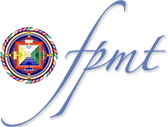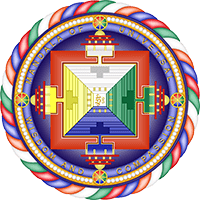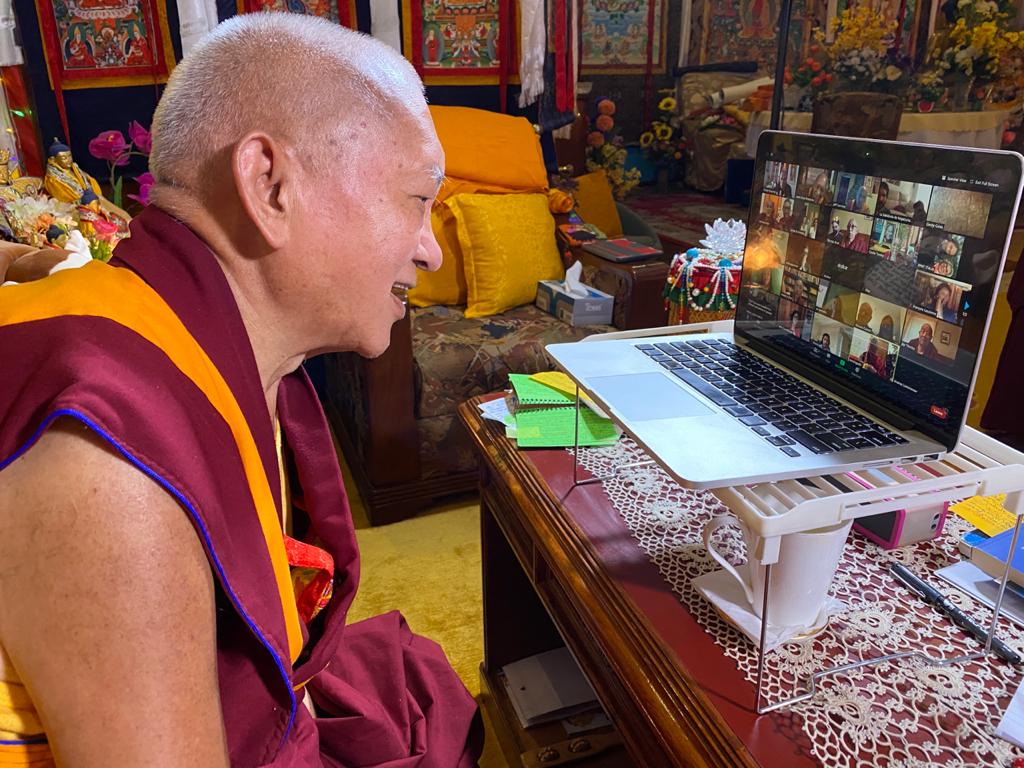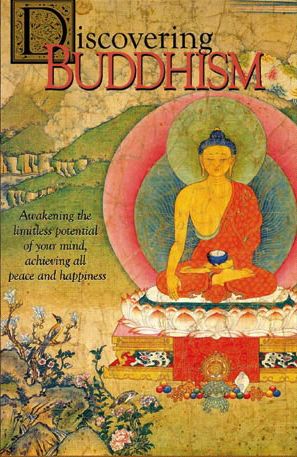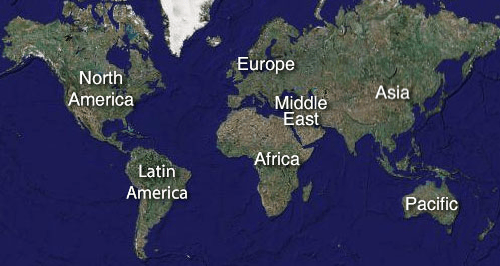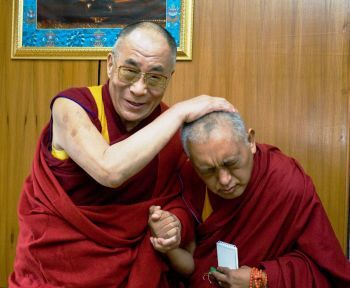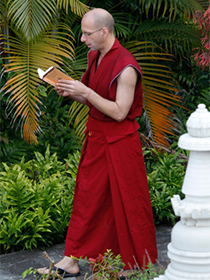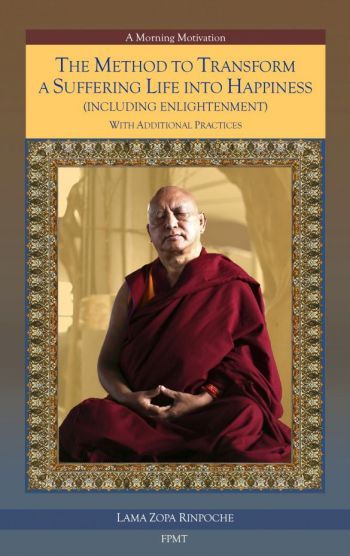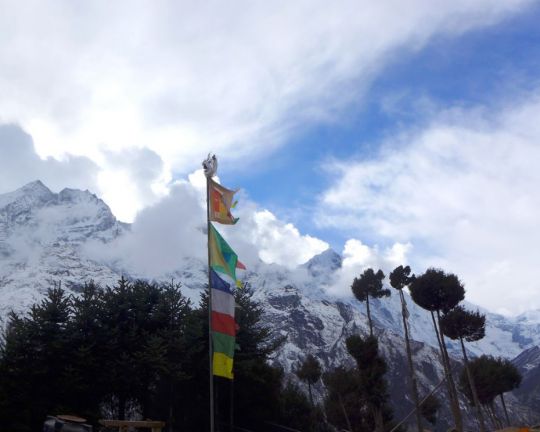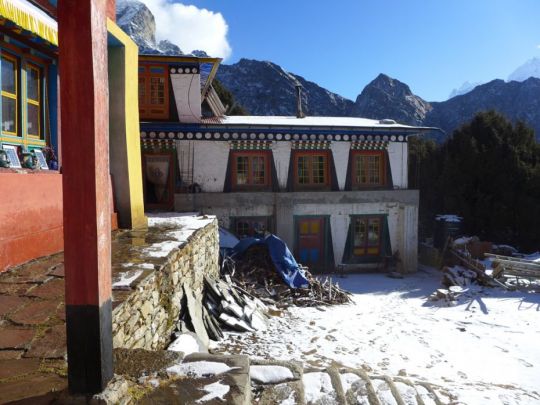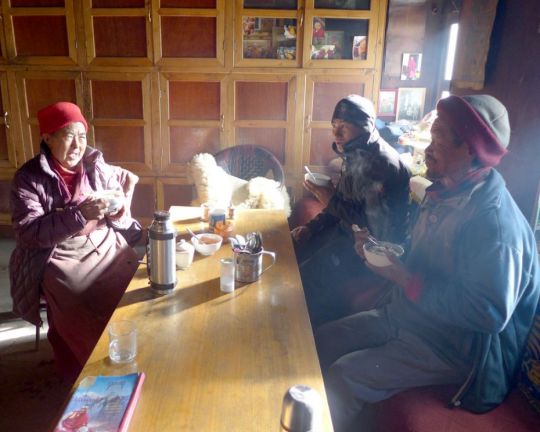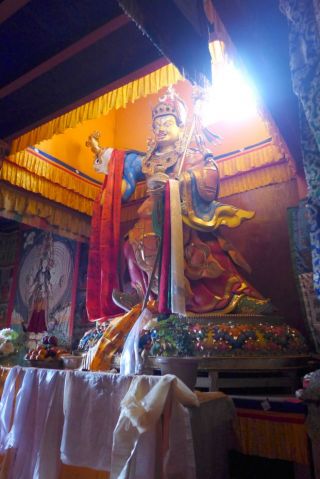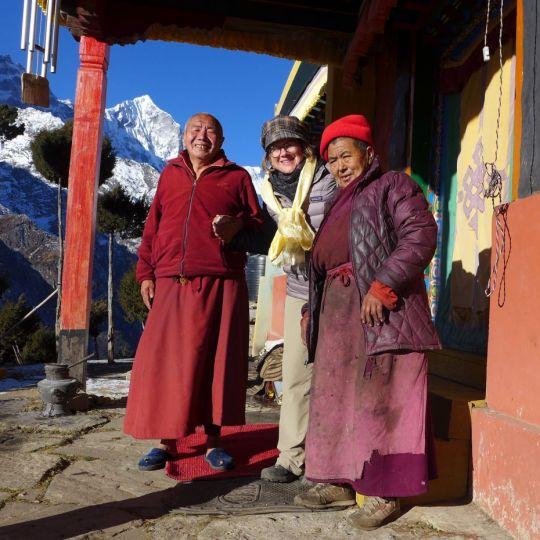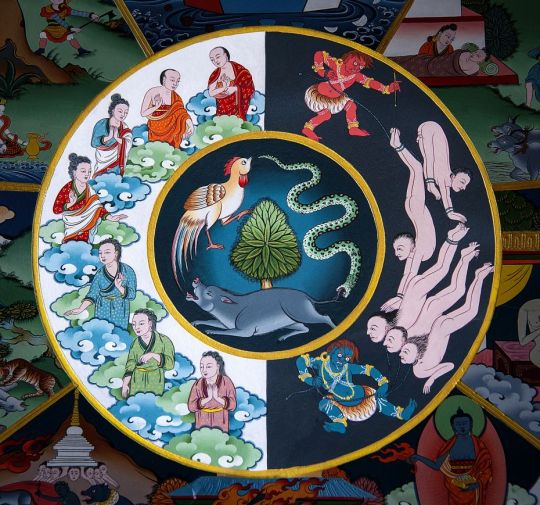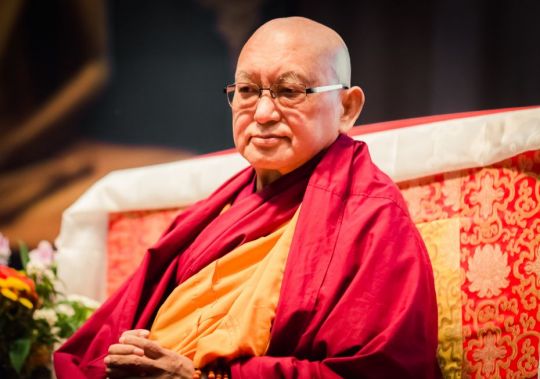- Home
- FPMT Homepage
Foundation for the Preservation of the Mahayana Tradition
The FPMT is an organization devoted to preserving and spreading Mahayana Buddhism worldwide by creating opportunities to listen, reflect, meditate, practice and actualize the unmistaken teachings of the Buddha and based on that experience spreading the Dharma to sentient beings. We provide integrated education through which people’s minds and hearts can be transformed into their highest potential for the benefit of others, inspired by an attitude of universal responsibility and service. We are committed to creating harmonious environments and helping all beings develop their full potential of infinite wisdom and compassion. Our organization is based on the Buddhist tradition of Lama Tsongkhapa of Tibet as taught to us by our founders Lama Thubten Yeshe and Lama Thubten Zopa Rinpoche.
- Willkommen
Die Stiftung zur Erhaltung der Mahayana Tradition (FPMT) ist eine Organisation, die sich weltweit für die Erhaltung und Verbreitung des Mahayana-Buddhismus einsetzt, indem sie Möglichkeiten schafft, den makellosen Lehren des Buddha zuzuhören, über sie zur reflektieren und zu meditieren und auf der Grundlage dieser Erfahrung das Dharma unter den Lebewesen zu verbreiten.
Wir bieten integrierte Schulungswege an, durch denen der Geist und das Herz der Menschen in ihr höchstes Potential verwandelt werden zum Wohl der anderen – inspiriert durch eine Haltung der universellen Verantwortung und dem Wunsch zu dienen. Wir haben uns verpflichtet, harmonische Umgebungen zu schaffen und allen Wesen zu helfen, ihr volles Potenzial unendlicher Weisheit und grenzenlosen Mitgefühls zu verwirklichen.
Unsere Organisation basiert auf der buddhistischen Tradition von Lama Tsongkhapa von Tibet, so wie sie uns von unseren Gründern Lama Thubten Yeshe und Lama Thubten Zopa Rinpoche gelehrt wird.
- Bienvenidos
La Fundación para la preservación de la tradición Mahayana (FPMT) es una organización que se dedica a preservar y difundir el budismo Mahayana en todo el mundo, creando oportunidades para escuchar, reflexionar, meditar, practicar y actualizar las enseñanzas inconfundibles de Buda y en base a esa experiencia difundir el Dharma a los seres.
Proporcionamos una educación integrada a través de la cual las mentes y los corazones de las personas se pueden transformar en su mayor potencial para el beneficio de los demás, inspirados por una actitud de responsabilidad y servicio universales. Estamos comprometidos a crear ambientes armoniosos y ayudar a todos los seres a desarrollar todo su potencial de infinita sabiduría y compasión.
Nuestra organización se basa en la tradición budista de Lama Tsongkhapa del Tíbet como nos lo enseñaron nuestros fundadores Lama Thubten Yeshe y Lama Zopa Rinpoche.
A continuación puede ver una lista de los centros y sus páginas web en su lengua preferida.
- Bienvenue
L’organisation de la FPMT a pour vocation la préservation et la diffusion du bouddhisme du mahayana dans le monde entier. Elle offre l’opportunité d’écouter, de réfléchir, de méditer, de pratiquer et de réaliser les enseignements excellents du Bouddha, pour ensuite transmettre le Dharma à tous les êtres. Nous proposons une formation intégrée grâce à laquelle le cœur et l’esprit de chacun peuvent accomplir leur potentiel le plus élevé pour le bien d’autrui, inspirés par le sens du service et une responsabilité universelle. Nous nous engageons à créer un environnement harmonieux et à aider tous les êtres à épanouir leur potentiel illimité de compassion et de sagesse. Notre organisation s’appuie sur la tradition guéloukpa de Lama Tsongkhapa du Tibet, telle qu’elle a été enseignée par nos fondateurs Lama Thoubtèn Yéshé et Lama Zopa Rinpoché.
Visitez le site de notre Editions Mahayana pour les traductions, conseils et nouvelles du Bureau international en français.
Voici une liste de centres et de leurs sites dans votre langue préférée
- Benvenuto
L’FPMT è un organizzazione il cui scopo è preservare e diffondere il Buddhismo Mahayana nel mondo, creando occasioni di ascolto, riflessione, meditazione e pratica dei perfetti insegnamenti del Buddha, al fine di attualizzare e diffondere il Dharma fra tutti gli esseri senzienti.
Offriamo un’educazione integrata, che può trasformare la mente e i cuori delle persone nel loro massimo potenziale, per il beneficio di tutti gli esseri, ispirati da un’attitudine di responsabilità universale e di servizio.
Il nostro obiettivo è quello di creare contesti armoniosi e aiutare tutti gli esseri a sviluppare in modo completo le proprie potenzialità di infinita saggezza e compassione.
La nostra organizzazione si basa sulla tradizione buddhista di Lama Tsongkhapa del Tibet, così come ci è stata insegnata dai nostri fondatori Lama Thubten Yeshe e Lama Zopa Rinpoche.
Di seguito potete trovare un elenco dei centri e dei loro siti nella lingua da voi prescelta.
- 欢迎 / 歡迎
简体中文
“护持大乘法脉基金会”( 英文简称:FPMT。全名:Foundation for the Preservation of the Mahayana Tradition) 是一个致力于护持和弘扬大乘佛法的国际佛教组织。我们提供听闻,思维,禅修,修行和实证佛陀无误教法的机会,以便让一切众生都能够享受佛法的指引和滋润。
我们全力创造和谐融洽的环境, 为人们提供解行并重的完整佛法教育,以便启发内在的环宇悲心及责任心,并开发内心所蕴藏的巨大潜能 — 无限的智慧与悲心 — 以便利益和服务一切有情。
FPMT的创办人是图腾耶喜喇嘛和喇嘛梭巴仁波切。我们所修习的是由两位上师所教导的,西藏喀巴大师的佛法传承。
繁體中文
護持大乘法脈基金會”( 英文簡稱:FPMT。全名:Found
ation for the Preservation of the Mahayana Tradition ) 是一個致力於護持和弘揚大乘佛法的國際佛教組織。我們提供聽聞, 思維,禪修,修行和實證佛陀無誤教法的機會,以便讓一切眾生都能 夠享受佛法的指引和滋潤。 我們全力創造和諧融洽的環境,
為人們提供解行並重的完整佛法教育,以便啟發內在的環宇悲心及責 任心,並開發內心所蘊藏的巨大潛能 — 無限的智慧與悲心 – – 以便利益和服務一切有情。 FPMT的創辦人是圖騰耶喜喇嘛和喇嘛梭巴仁波切。
我們所修習的是由兩位上師所教導的,西藏喀巴大師的佛法傳承。 察看道场信息:
- FPMT Homepage
- News/Media
-
- Study & Practice
-
-
- About FPMT Education Services
- Latest News
- Programs
- New to Buddhism?
- Buddhist Mind Science: Activating Your Potential
- Heart Advice for Death and Dying
- Discovering Buddhism
- Living in the Path
- Exploring Buddhism
- FPMT Basic Program
- FPMT Masters Program
- FPMT In-Depth Meditation Training
- Maitripa College
- Lotsawa Rinchen Zangpo Translator Program
- Universal Education for Compassion & Wisdom
- Online Learning Center
-
- Prayers & Practice Materials
- Overview of Prayers & Practices
- Full Catalogue of Prayers & Practice Materials
- Explore Popular Topics
- Benefiting Animals
- Chenrezig Resources
- Death & Dying Resources
- Lama Chopa (Guru Puja)
- Lama Zopa Rinpoche: Compendium of Precious Instructions
- Lama Zopa Rinpoche: Life Practice Advice
- Lama Zopa Rinpoche Practice Series
- Lamrim Resources
- Mantras
- Prayer Book Updates
- Purification Practices
- Sutras
- Thought Transformation (Lojong)
- Audio Materials
- Dharma Dates - Tibetan Calendar
- Translation Services
- Publishing Services
- Ways to Offer Support
- Prayers & Practice Materials
-
- Teachings and Advice
- Find Teachings and Advice
- Lama Zopa Rinpoche Advice Page
- Lama Zopa Rinpoche: Compendium of Precious Instructions
- Lama Zopa Rinpoche Video Teachings
- ༧སྐྱབས་རྗེ་བཟོད་པ་རིན་པོ་ཆེ་མཆོག་ནས་སྩལ་བའི་བཀའ་སློབ་བརྙན་འཕྲིན།
- Podcasts
- Lama Yeshe Wisdom Archive
- Buddhism FAQ
- Dharma for Young People
- Resources on Holy Objects
- Teachings and Advice
-
-
*If a menu item has a submenu clicking once will expand the menu clicking twice will open the page.
-
-
- Centers
-
- Teachers
-
- Projects
-
-
-
-
*If a menu item has a submenu clicking once will expand the menu clicking twice will open the page.
-
-
- FPMT
-
-
-
-
-
My religion is kindness to all
His Holiness the Dalai Lama
-
-
-
- Shop
-
-
-
The Foundation Store is FPMT’s online shop and features a vast selection of Buddhist study and practice materials written or recommended by our lineage gurus. These items include homestudy programs, prayers and practices in PDF or eBook format, materials for children, and other resources to support practitioners.
Items displayed in the shop are made available for Dharma practice and educational purposes, and never for the purpose of profiting from their sale. Please read FPMT Foundation Store Policy Regarding Dharma Items for more information.
-
-
FPMT Community: Stories & News
24
The Mahayana Children’s Programme, a program of FPMT Mongolia, is now celebrating its tenth anniversary. To mark the occasion, FPMT Mongolia director Ianzinha Bartanova shared a video of the children, recorded in Ulaanbaatar, the nation’s capital. Ianzinha writes the following about the video and the Mahayana Children’s Programme:
In the video below the youngest group of the Mahayana Children’s Programme participants, ranging in age from six to eight years, happily recite mantras in Mongolian and dedicate all merit from their practice to Lama Zopa Rinpoche’s long life.
Before they commence the mantra recitation, the children generate the correct motivation as follows: “I will do these recitations in order to be beneficial to my country, and all the six-realm sentient beings, and for my family, and myself to be happy, and to have good qualities such as perseverance, patience, responsibility, and friendliness.”
Currently practicing memorization, the children wholeheartedly enjoy the recitation of the following mantras and prayers: Guru Shakyamuni Buddha, Chenrezig, Manjushri, Vajrapani, the prostration mantra, Tara, Medicine Buddha, Vajrasattva, the mantra to bless offerings, and Migtsema.
As the children have a deep appreciation for the importance of dedication in practice, they concluded with these wishes: “Due to these merits collected, may I and my family be happy! May the most precious and kind Lama Zopa Rinpoche have a long and healthy life, and may Rinpoche lead us in all future lives!”
On behalf of all FPMT Mongolia staff and students, we would like to join with the children and dedicate all our merits accumulated during 2017 for Rinpoche’s long, healthy, and stable life. We rejoice in all meritorious actions done by the FPMT family, and from the bottom of our hearts, we wish you all a very happy and prosperous new year!
Learn more about the work of FPMT in Mongolia: http://www.fpmtmongolia.org
Learn more about the Mahayana Children’s Programme:
http://www.fpmtmongolia.org/mahayana-childrens-programme
FPMT.org and Mandala Publications brings you news of Lama Zopa Rinpoche and of activities, teachings and events from over 160 FPMT centers, projects and services around the globe. If you like what you read, consider becoming a Friend of FPMT, which supports our work.
- Tagged: fpmt mongolia, mahayana childrens program
19
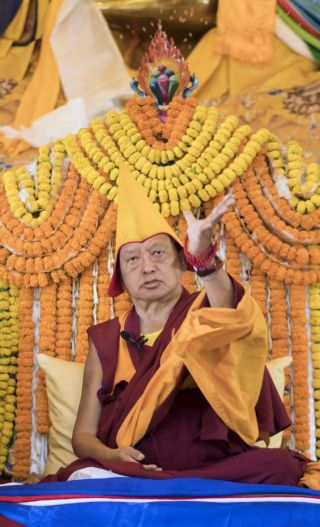
Lama Zopa Rinpoche during the official long life puja offered at Kopan Monastery, Nepal, December 14, 2017. Photo by Ven. Lobsang Sherab.
We invite you to enjoy our January e-News.
This month we bring you:
- How to Report your Recitations for Lama Zopa Rinpoche’s Health
- Rejoicing in Another Year of Charitable Giving
- Two New Stories from Mandala magazine
- Two New FPMT Study Groups
… and more, with lots of lovely photos!
The FPMT International Office News comes from your FPMT International Office. Visit our subscribe page to receive the FPMT International Office News directly in your email box.
17
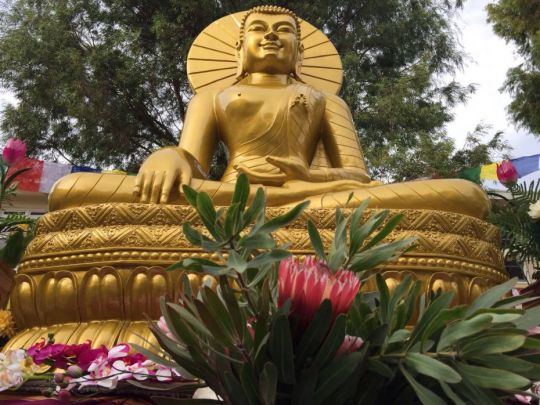
Buddha statue prior to offering gold-leaf at the Guru bumtsog, Hobart, Tasmania, June 2016. Photo courtesy of Stephanie Brennan.
In June 2017, FPMT in Australia (FPMTA) and Chag Tong Chen Tong Tibetan Buddhist Centre (CTCT) organized 100,000 tsog offerings to Guru Rinpoche, also known as a “Guru bumtsog.” More than 160 students from twenty or so Australian FPMT centers, projects, and services traveled to Hobart, Tasmania, to take part in the powerful and joyous multi-day event.
In a new Mandala online feature, “The Power of Guru Rinpoche: The Heart-Opening Guru Bumtsog Experience,” Stephanie Brennan, FPMTA National Education/Tour Coordinator, shares her personal account of the Guru bumtsog experience.
“… After chai and cake were served, the first puja session began. With eighteen Sangha present from all over Australia, the gompa was filled with maroon and saffron robes. Sitting in front were two geshes—Geshe Tenzin Zopa, who led the puja, and Geshe Phuntsok Tsultrim, the resident geshe at Chenrezig Institute, Queensland. Also in front was Lama Jimay from Tasmania, who ably assisted with the hook drum,” Stephanie writes.
“In the first session, we started by chanting the full verses of the ‘Prayer to Guru Rinpoche That Spontaneously Fulfills All Wishes’ to a poignant and melodic tune. This was followed by the tsog offering prayer and Guru Rinpoche mantra, which were repeated many times. These repetitions were accompanied by cymbals and drums with a very stirring beat. As the pace of these repetitions was fast, it took a little while for everyone to get their head around the Tibetan syllables, but soon everyone settled into a kind of rhythm, with Geshe Tenzin Zopa’s clear voice leading us forward.
“Sangha members played the ritual instruments, and the gompa became warm and energized. As I looked at the large thangka of Guru Rinpoche above the tsog offerings, it felt to me that evoking the spirit of Guru Rinpoche and knowing that this puja had been blessed by Lama Zopa Rinpoche beforehand, particularly to clear obstacles, made everything in the gompa seem timeless, vivid, and very clear. …”
Read Stephanie Brennan’s article “The Power of Guru Rinpoche: The Heart-Opening Australian Guru Bumtsog Experience” in its entirety:
https://fpmt.org/mandala/in-depth-stories/the-power-of-guru-rinpoche-the-heart-opening-australian-guru-bumtsog-experience
FPMT.org and Mandala Publications brings you news of Lama Zopa Rinpoche and of activities, teachings, and events from over 160 FPMT centers, projects and services around the globe. If you like what you read, consider becoming a Friend of FPMT, which supports our work.
10
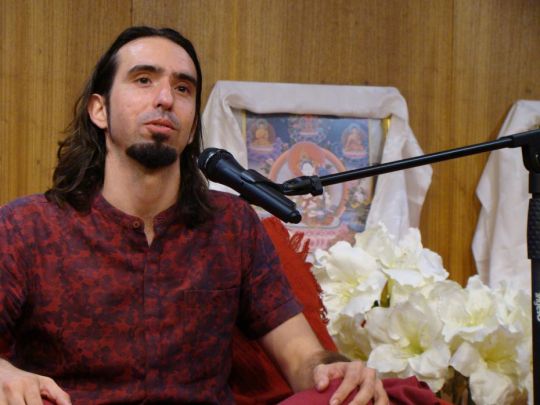
Tenzin Ösel Hita giving a talk at Centro Shiwa Lha, Rio de Janeiro, Brazil, September 2017. Photo courtesy of Centro Shiwa Lha.
Tenzin Ösel Hita, the recognized reincarnation of FPMT founder Lama Yeshe, gave a talk at Centro Shiwa Lha in Rio de Janeiro in Brazil in September 2017. (At the beginning of 2017, Ösel toured European FPMT centers giving talks to hundreds of Dharma students.) Neyl Soares, director of Centro Shiwa Lha shared this update from Ösel’s visit:
Recently renovated and opened just six months ago, the building that houses Centro Shiwa Lha is a historic 19th-century house. Due to construction work, the center’s teaching and events calendar has been a work in progress. But a benefit of the remodeling process is that all activities can now be accommodated more comfortably in the new meditation and talks room, which has a capacity of up to sixty people. Upstairs in the building are guest teacher accommodations and outside there is a small yard with a guava tree and two papaya trees.
When we learned of Ösel Hita Torres coming to Brazil, we hurried to invite him for an informal visit and a talk. As we prepared for the talk, we were surprised to see that the projected audience numbers had quickly surpassed our permitted capacity. So, we moved the venue to a conference room in the neighborhood that would accommodate a large crowd.
While preparing the hired conference room, we noticed that there were resources to broadcast Ösel’s talk live to several FPMT centers, Facebook pages, and other social media platforms. To help in our desired broadcast of the talk, FPMT International Office put us in touch with Alexis Benelhadj, IT manager at Istitut Vajra Yogini in France. Alexis provided access to a streaming server, which allowed us to stream video to many destinations—our Facebook page and YouTube channel, the Lama Yeshe Wisdom Archive page, and Ösel’s own website—allowing us to reach even more people than we had initially imagined possible. The streaming connected people in various parts of the planet, benefiting many people.
Ösel arrived a couple of days in advance of his scheduled talk, so we had the chance to show him some of the sights and sounds of Rio.

Tenzin Ösel Hita giving a talk at Centro Shiwa Lha, Rio de Janeiro, Brazil, September 2017. Photo courtesy of Centro Shiwa Lha.
During the event, the venue was packed with people of various ages and from different Dharma communities, all curious to listen Ösel talk. He was surprised by the number of people in attendance who were able to understand Spanish, but promised that since now he lives in Brazil, his next talk would be without translation.
After warming up the audience with a meditation focused on breathing and prayers, Ösel was clearly at ease. He quickly dismissed his notes and conducted the talk as if seated in the living room with family. Mostly the talk was in English with translation for the Brazilian attendees, but Ösel also used Spanish and a little Portuguese to clarify a number of points.
Overall, a highly successful event was delivered with lightness, and a keen spirit, which has resulted in giving us a sense of preparedness for the new season, and encourages us to engage in future responsibilities.
During his talk Ösel revealed that now he will live in Curitiba, southern Brazil, with his wife, who at the time was pregnant and expecting in one or two weeks. He told us that Centro Shiwa Lha will be his home in Rio de Janeiro. And baby Tenzin Norbu arrived within days!
Congratulations on your new baby, Indila and Ösel! ¡Enhorabuena por el bebé nuevo! Bem-vindo, Tenzin Norbu! May many benefit!
Watch Tenzi Ösel Hita talk at Centro Shiwa Lha in Rio de Janeiro:
https://www.youtube.com/Z3sC9Y-7uco
Find more information about Tenzin Ösel Hita on his resource page on FPMT.org, including news, photos, videos, and links to his official Facebook page:
https://fpmt.org/fpmt/osel/
Learn more about Centro Shiwa Lha in Rio de Janeiro.
The Big Love Fund provides financial resources that enable Tenzin Ösel Hita to continue his endeavors on behalf of FPMT.
- Tagged: brazil, centro shiwa lha, tenzin osel hita
3
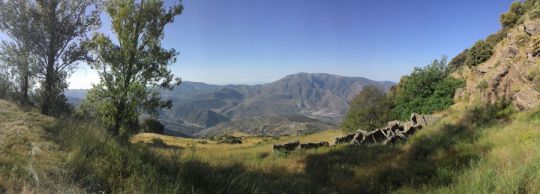
Mountain view from Oseling Retreat Center, October 2017. Photo courtesy of Oseling Retreat Center.
Oseling Retreat Center, in the Andalusia region of Spain, has undertaken a new project. In response to advice from Lama Zopa Rinpoche, the center has begun work on the planning, construction, and fund-raising aspects for a new nunnery that will provide a home and learning facility for European nuns. Center director Anne Wenaas describes the project for Mandala:
Lama Zopa Rinpoche advised Oseling Retreat Center in Spain to establish a nunnery within its grounds. In keeping with Rinpoche’s vision, construction has recently commenced on a project that promises to provide a “powerhouse of Dharma practice” for European nuns.
It is of great importance for all the nuns to have a place to live, so that they can observe a monastic life and dedicate their lives to study, contemplation, and meditation. The living costs for each nun will be very low, only food and maintenance will be needed.
Oseling is situated in the Sierra Nevada, a mountain range about forty kilometers (twenty-five miles) from the coast and within traveling distance of the city of Granada. The center is quite high up the mountains, forming a large portion of the top of a mountain within the National Park.
If you are familiar with Oseling, the location of the nunnery will be just below the Tara statue, a wonderful place with a wide view of the whole valley. Construction of the nunnery has recently begun.

Architect’s drawing of the proposed nunnery at Oseling. Image courtesy of Oseling Retreat Center.
This is a very beneficial project, and practitioners at the center will all have a great and unique opportunity to help realize Rinpoche’s ambition. They encourage everyone to participate and hope to quickly raise the funds necessary to finish construction.
It is the center’s hope that Tara’s prayer will inspire the future community of nuns:
“There are many who desire Enlightenment in a man’s body, but none who works for the benefit of the sentient beings in the body of a woman. Therefore, until samsara is empty, I shall work for the benefit of sentient beings in a female body.”
Developments of the construction project will be shared via the Oseling Facebook page.
For more information or to offer support, please contact Oseling via their email: oficina@oseling.com
More information, photos, and updates about FPMT spiritual director Lama Zopa Rinpoche can be found on Rinpoche’s webpage on FPMT.org. If you’d like to receive news of Lama Zopa Rinpoche and FPMT via email, sign up to FPMT News.
- Tagged: osel nunnery, oseling retreat center
27
Lawudo Retreat Centre, located in the Solu Khumbu district of Nepal, is where FPMT spiritual director Lama Zopa Rinpoche’s previous incarnation meditated and not far from the village where Rinpoche was born. Mandala editor Laura Miller visited Lawudo in early 2017 and shared this reflection on her experience there.
Visiting Lawudo, high in the Himalayan mountains of Nepal, had been a wish of mine for nearly eight years. And on New Year’s day 2017, my tired legs trudged up the final steep path and carried me into the yard in front of the Lawudo Gompa. Lama Zopa Rinpoche’s sister, Ani Ngawang Samten, stood there as I approached. Tears formed in my eyes when I took her hands, which seemed so soft to me despite five decades of tireless work looking after the holy retreat site. All I could say to her was how happy I was to finally be there. The previous year, my sense of personal accomplishment had sunk to a difficult low. But there I was, standing just under 13,000 feet [4,000 meters], in a place surrounded by gorgeous mountains and graced by highly accomplished practitioners. Just being there, I had achieved something that felt profoundly worthwhile and a little adventurous.
Before starting my trek to Lawudo, I’d read The Lawudo Lama, an invaluable book by Ven. Jamyang Wangmo that tells the story of the inspiring lives of Lawudo Lama Kunzang Yeshe and his reincarnation Lama Zopa Rinpoche, as well as offers a detailed description of the religious and cultural history of the Mount Everest region, where Lawudo is situated. As my Sherpa guide Nursang and I walked over several days up the trail from the airstrip in Lukla to Namche Bazaar to Thame, Lama Zopa Rinpoche’s birthplace, and finally to Lawudo, the mani stones, prayer wheels, stupas, and gompas created endless opportunities for receiving blessings, rejoicing, and contemplating how generations of Sherpas, who populate the area, had made Dharma practice integral to daily life.
I can date the origin of my trip back to the time when I did a little volunteer work for Mandala magazine. While working on something for the former editor, I visited the website for Lawudo Retreat Centre. The thought “I want to go there” shot directly through my mind as I scrolled through photos of the cave where the Lawudo Lama meditated and of the Lawudo Gompa and the mountains and valley that surround them. During the past six years that I’ve worked as the editor of Mandala, I’ve read and re-read stories about Lawudo: the early years when Lama Yeshe and Rinpoche visited; the young boys who became the first Kopan monks; the experiences of Westerner students who traveled there to practice; and Ani Ngawang Samten, who still keeps it all going. When the earthquake devastated Nepal in 2015, I, along with many, many others, anxiously awaited news of what happened in Lawudo.
Fortunately, Lawudo survived and everyone there was OK. When my opportunity came to visit, like so many before me, I spent many happy hours in Ani-la’s smoky kitchen. I intently ate her nourishing food and listened to her first-hand stories of the early days and to her concerns about the always tenuous water supply and what will happen to Lawudo when she can no longer take care of it. That said, Ani-la didn’t seem to care much to talk about the earthquake. The building that contains the kitchen, dining room, and her own room, received significant damage, as did several other buildings, including the gompa and library. She lived in a tent for months while repairs were being made. During my visit, it appeared that most of the major repairs had been done thanks to generous support from the Nepal Earthquake Support Fund.
The story I enjoyed most from Ani-la recounted the fraught, weeks-long effort to bring the very large Guru Rinpoche statue up to Lawudo and into the gompa. There are no roads in the upper Solu Khumbu district. Humans and yaks carry all nature of things in this remote area; helicopters bring in larger goods and shipments. The beautiful Guru Rinpoche statue stands 13.5 feet [14 meters] tall, far too large to be carried very far. In fact, it is so tall that part of the ceiling of the gompa had to be removed in order for it to fit. My retelling of Ani-la’s story wouldn’t do it justice, but her account covered a succession of false starts, involving a very big helicopter, bad weather, drunken pilots, and the statue being stuck inside the helicopter until it wasn’t. The story ended with an auspicious rainbow surrounding the helicopter on its arrival at Mende, just below Lawudo, and the two dozen Sherpas who carried the precious holy object up the steep hill and into the gompa. The Padmasambhava Project for Peace covered the cost of inviting this impressive statue to Lawudo as well as its creation and that of nine other smaller statues of Guru Rinpoche that are now in the Lawudo Gompa.
My visit to Lawudo was short, just a taste. I had one afternoon to meditate in the Lawudo Lama’s cave. But like receiving even a short Dharma teaching from a Buddhist master, that experience had a deep and lasting effect. Thinking about it now, the dollars spent, the hard work of the hike up, the rough accommodations, and the misgivings about the elevation and the state of my body all seem so minuscule when I compare them to simply being able to be in that cave. I hope and dedicate that anyone else who wishes to go to Lawudo be able to do so and that I am able to return. I rejoice and am grateful for all who have supported the Lawudo Retreat Centre over the years and pray that it may continue on for a very long time.
The author thanks Effie Fletcher at Himalayan High Treks and Dharma Journeys Pilgrimages, and Amber Tamang at Three Jewels Adventures for their help with arrangements for the trek.
FPMT.org brings you news of Lama Zopa Rinpoche and of activities, teachings and events from over 160 FPMT centers, projects and services around the globe. If you like what you read, consider becoming a Friend of FPMT, which supports our work.
- Tagged: lawudo, lawudo retreat centre, nepal earthquake support fund, padmasambhava project for peace
22
Seasons Greetings, and December FPMT E-News!
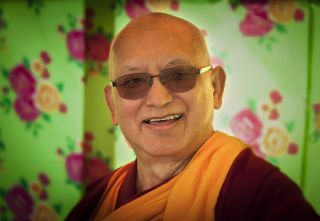
Lama Zopa Rinpoche, Italy, October 2017. Photo by Piero Sirianni.
Warm Seasons Greetings from Lama Zopa Rinpoche and FPMT International Office!
Our greetings come as part of the December FPMT International Office e-News.
As well as our greetings of the season, we bring you:
- A Reminder about Updates to Rinpoche’s Schedule
- Our Year-End Generosity Campaign
- Welcome to the New Issue of Mandala magazine!
- Rejoicing about: A New FPMT Center, and 2 New Study Groups!
Two Fruitful Foundation Service Seminars!
… and more, with lots of lovely photos!
The FPMT International Office News comes from your FPMT International Office. Visit our subscribe page to receive the FPMT International Office News directly in your email box.
20
Venerable Bhikshus, whoever sees dependent and relative origination, sees the Dharma.
Whoever sees the Dharma, sees the Buddha.
What is this dependent and relative origination of which I speak?
It is this: because this exists, that arises. Because this is born, that is born.
It is like this: through the condition of ignorance, compounding factors. From the condition of compounding factors, consciousness … name and form … the six sense spheres … contact … feeling … craving … grasping … existence … birth … aging and death. From the condition of aging and death, agony, wailing, suffering, unhappiness, and mental disturbance all arise. Like that, merely this enormous heap of suffering arises.
—From the Salistamba, or Rice Seedlings Sutra, [translation by Ven. Tenzin Gache] the primary source of teachings on the twelve links of dependent arising.
In his new article for Mandala titled “Personalizing the Twelve Links of Dependent Origination,” Ven. Tenzin Gache shares a comprehensive view of what Lama Tsongkhapa considered to be the most profound teaching from the Buddha.
Exploring each of the twelve links, Ven. Tenzin offers a clear depiction of this Dharma topic, which many practitioners consider to be an elusive subject, and in doing so he offers a thorough account of one of Mahayana Buddhism’s most significant teachings.
Read Ven. Tenzin Gache’s new article “Personalizing the Twelve Links of Dependent Origination” in its entirety:
https://fpmt.org/mandala/in-depth-stories/personalizing-the-twelve-links-of-dependent-origination/
Find more in-depth stories and interviews on Mandala:
https://fpmt.org/mandala/in-depth-stories/
Mandala is offered as a benefit to supporters of the Friends of FPMT program, which provides funding for the educational, charitable and online work of FPMT.
13
Mandala January-June 2018 Out Now!
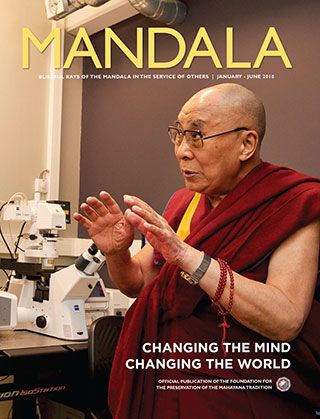
His Holiness the Dalai Lama talking with scientists during his visit to the Université de Strasbourg, France, September 2016. Photo by Olivier Adam.
In our just published Mandala January-June 2018, we explore what Buddhism offers the world in times of global difficulties to help pacify suffering and bring about peace.
As a preview to the print edition, we have made the cover story, “Changing the Mind, Changing the World: The Mind, Karma, and Global Change,” available to read online.
Also in this issue:
- His Holiness the Dalai Lama encourages Buddhists to share the wisdom and thinking of the Buddha and the Nalanda masters in secular ways;
- The Foundation for Developing Compassion and Wisdom offers snapshots of its activities around the world;
- Several FPMT centers, projects, and services share their approaches to being compassionate world citizens; and
- We take an in-depth look at the Inner Job Description, a mindfulness practice tool designed to help those offering service or working in any job transform their efforts into profound, powerful Dharma practice.
Plus, teachings from Lama Yeshe, Lama Zopa Rinpoche, new photos, interviews, and much more!
Find all our exclusive online stories for Mandala January-June 2018 and information on how to receive a print copy here:
https://fpmt.org/mandala/archives/mandala-for-2018/january-june/
Mandala is offered as a benefit to supporters of the Friends of FPMT program, which provides funding for the educational, charitable and online work of FPMT. The new issue is also available through the FPMT Foundation Store.
- Tagged: mandala
6
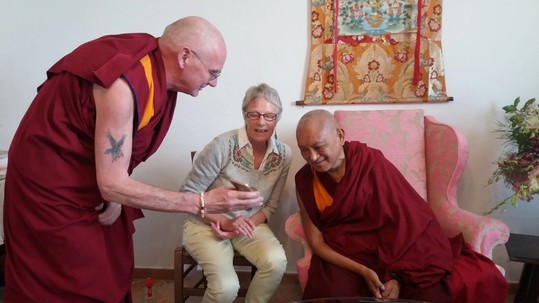
Lama Zopa Rinpoche being shown the Inner Job Description app on a phone, with Ven. Roger Kunsang and Wendy Ridley, Istituto Lama Tzong Khapa, Italy, October 2017. Photo by Violette Pilot.
Would you like help in transforming your daily life into Dharma practice? If so, the Inner Job Description App is for you.
Initially produced as a card for practitioners to write upon, the Inner Job Description (IJD) is now available as an app for mobile devices.
Like the ‘pen and paper’ version of the IJD, the app is tool for developing mindfulness of our thoughts, speech, and actions. By using the IJD daily, our increased awareness of self-defeating mental habits can allow us to change our minds in positive ways.
As Lama Zopa Rinpoche notes in “How to Be a Real Professional,” “You have all these external professions—how to do this, how to do that from school, college, and university—but without inner professionalism: how to live life, how to do everything mentally, how to do everything—business or professional activity, whatever you do—with pure attitude, positive mind, non-ignorance, non-anger, non-attachment, especially with the non-selfish mind.” By tracking your behavior over time, you will learn how to make every day a profound inner practice.

A screen shot of the Inner Job Description App landing page.
The Inner Job Description was designed to help us understand how we can develop as “inner professionals,” transforming our service into Dharma practice.
The app enables you to track your progress throughout the day, and then to review how you are developing as an inner professional. You can choose to receive regular reminders from the app in the form of inspiring quotes by Lama Zopa Rinpoche and Lama Thubten Yeshe.
We invite you to use the IJD Mindfulness Practice App to become an inner professional. Download the Inner Job Description App for free on Google Play and the Apple App Store (search for Inner Job Description).
The app is due to the kindness of a generous sponsor, allowing the digital IJD to be offered free of charge. Currently the app is only available in English, but we are exploring the possibility of making the app available in other languages.
The Inner Job Description practice is an essential part of the FPMT Foundation Service Seminar, which we recommend to anyone already offering, or considering offering, service in the FPMT organization
Look out for an interview with Amy Cayton, FPMT Service Seminar Coordinator, about the IJD and the Foundation Service Seminar, in the January–June 2018 issue of Mandala magazine.
Learn more about the Inner Job Description online, where you can downlowd the IJD Card, watch a video on how to use the IJD, and find links to the app:
https://fpmt.org/education/training/inner-job-description/
Mandala is offered as a benefit to supporters of the Friends of FPMT program, which provides funding for the educational, charitable and online work of FPMT.
FPMT.org and Mandala Publications brings you news of Lama Zopa Rinpoche and of activities, teachings, and events from over 160 FPMT centers, projects, and services around the globe. If you like what you read, consider becoming a Friend of FPMT, which supports our work.
- Tagged: ijd, inner job description
29
In September of this year, Lama Zopa Rinpoche visited Panchen Losang Chogyen Gelugzentrum (PLC) in Austria. This was Rinpoche’s first official visit and the first opportunity for Austrian students to attend teachings, receive an initiation, and to take refuge from Rinpoche. Center director Stefan Seidler shares a brief overview of Rinpoche’s time in Vienna:
In September, Lama Zopa Rinpoche arrived for the first time in Vienna. Many of us are still feeling the presence of our precious guru in our hearts and minds.
From the very first moments at the airport, where spiritual program coordinator Andrea Husnik, myself, and many students from Panchen Losang Chogyen Gelugzentrum welcomed him, everybody felt Rinpoche‘s incredible kindness, generosity, and the warmth of heart.
After one night in a hotel, Rinpoche and his entourage moved into a wonderful old house in a quiet area in the north of Vienna, where they would stay for the next two weeks and which had been offered very generously by the parents of one of PLC’s board members.
Hard work was required to prepare the house for so many visitors, and the benefits everybody received from Rinpoche have been enormous. He was so kind to share much of his precious time with the host family, even learning how to make apple strudel. Rinpoche’s mere presence—his wisdom, his laugh, his never-ending kindness to everyone in the house—gave them all so much inspiration that every domestic task became a pure joy.
Also during the visit, all of the center’s board members and main volunteers had the opportunity to spend time with Rinpoche. As almost none of the center members in Vienna had met Rinpoche before, this visit was an amazing and rare opportunity for all of them. A very nice dinner for board members and volunteers was held in Vienna’s city center, and a wonderful, inspiring private visit to the center itself prepared us all for the big weekend to come.
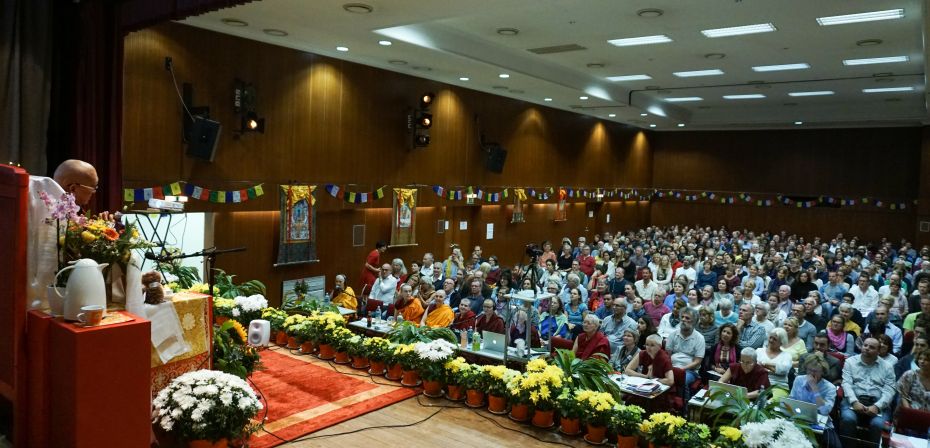
Lama Zopa Rinpoche teaching in Vienna, Austria, September 2017. Photo courtesy of Ven. Sherab.
Almost 400 people registered and the venue, which we had rented, was fully packed for all three days. Besides people from Austria and Germany, many others traveled from all over Europe to visit Vienna. We had guests from Spain, the UK, the Czech Republic, Switzerland, France, Italy and many more countries, all eager to attend Rinpoche’s teachings.
Rinpoche’s teachings were amazing. With the help of transcriber Ven. Joan Nicell and translators Ven. Birgit Schweiberer and Ven. Paloma Alba, we were able to understand Rinpoche’s limitless wisdom.
After the teachings, Rinpoche also gave refuge. More than 50 people took refuge and, for most of them, this was also their first chance to have direct contact with Rinpoche. Later, attendees received a Medicine Buddha initiation.
For everybody from the Vienna center, everybody who attended the teachings, and of course everybody who helped plan, organize, and prepare this great visit, we’re sure the benefits and inspiration of the visit will last for a long time. PLC is very grateful that we could host our guru Lama Zopa Rinpoche and we hope he will come back very soon!
Watch Lama Zopa Rinpoche’s September 2017 teachings in Vienna, Austria, on Rinpoche Available Now:
https://fpmt.org/media/streaming/teachings-of-lama-zopa-rinpoche/lama-zopa-rinpoche-teachings-vienna-tabs/
For more information on the programs and schedule of Panchen Losang Chogyen Gelugzentrum:
http://www.gelugwien.at
FPMT.org and Mandala Publications brings you news of Lama Zopa Rinpoche and of activities, teachings, and events from over 160 FPMT centers, projects and services around the globe. If you like what you read, consider becoming a Friend of FPMT, which supports our work.
- Tagged: great medicine buddha initiation, lama zopa rinpoche, panchen losang chogyen, panchen losang chogyen gelugzentrum
22
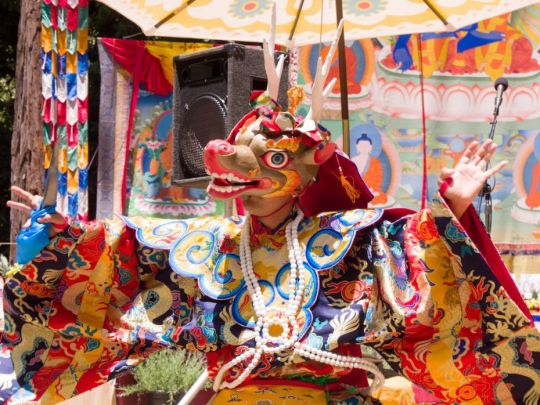
Tenzin Monlam performs the deer dance at Land of Medicine Buddha, Soquel, California, US, July 2017. Photo courtesy of Denice Macy.
Building projects manager Denice Macy at Land of Medicine Buddha (LMB) in California recently shared a useful how-to list for hosting a large-scale Dharma event:
In November 2002, Sally Barraud, then director of Land of Medicine Buddha, received advice from Lama Zopa Rinpoche to host a Medicine Buddha Festival at LMB at least once a year. Pearls of wisdom flowed from Rinpoche’s mouth—the advice of what to do, what to offer. With unwavering faith, Sally went to work with her team and the local community to host the first Medicine Buddha Festival. Sally reached out to Geshe Ngawang Drakpa from Tse Chen Ling in San Francisco, Ven. Donyo at Gyuto Vajrayana Center in the Bay Area, and Tam To, a local leader of the Vietnamese community in San Jose. Eight months later, the festival became a reality.
What follows is some practical advice that we have learned from hosting the Medicine Buddha Festival for the past fifteen years.
Before anything—go for refuge.
We are in service to our guru, who is at times, a hilarious comic. Have fun (Rinpoche does), laugh at mistakes (Rinpoche does), experience it all with compassion (Rinpoche does)! Buckle up and get ready for a fun and wild ride by hosting a large Dharma event to benefit others!
1. Identify the main purpose of your event.
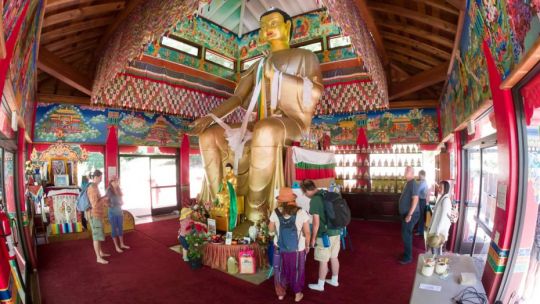
Wish Fulfilling Temple, Land of Medicine Buddha, Soquel, California, US, July 2017. Photo courtesy of Denice Macy.
This will be your guide as you organize your event. For LMB, the main purpose as advised by Rinpoche was and is to give as many people as possible the opportunity to take part in the Medicine Buddha puja, to learn about the Medicine Buddha, to provide people with the opportunity to make extensive offerings to please the Buddha, and the opportunity to create imprints and merit! Easy enough!
2. Plan well ahead!

Attendees at the Land of Medicine Buddha festival in Soquel, California, US, July 2017. Photo courtesy of Denice Macy.
A successful LARGE event, Dharma or secular, needs to be planned well in advance. We look at dates as much as a year in advance. Some of the factors we consider include: the weather, dates of public holidays, seasonal events, other regularly scheduled festivals, and community events. If you fail to consider these factors, you may find that people who might benefit from your event are otherwise previously committed or that the weather is a bummer. Big party, big fun, big love!
3. Speaking of big, think BIG!

Mani prayer wheel at the Land of Medicine Buddha in Soquel, California, US, July 2017. Photo courtesy of Denice Macy.
Rinpoche helps us to identify how to please and benefit sentient beings. Consider the many different dispositions of sentient beings. Some people might attend because they love the delicious free food, others might have interest in the Tibetan culture, others want to connect with community, others have strong karmic connection to the Dharma, and some are looking for a wholesome family event—so provide varied opportunities. We have yet to provide pony rides around our stupa as Rinpoche requested, but it is in the plans! Not only would this benefit the ponies, but also the kids who would ride or lead them around the stupa.
4. Consider varied potential interest groups in your community.
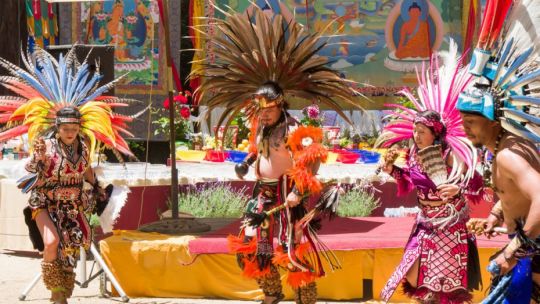
Sun Family Meixca Dance – Medicine Buddha Festival in Soquel, California, US, July 2017. Photo courtesy of Denice Macy.
Shine the Dharma light, spread your net wide. Let people know about your event; it is a priceless opportunity for you to connect and benefit others. We pay for advertising on the local public radio stations, in the weekly community newspaper, and sponsor adverts on Facebook. Don’t forget to take advantage of free media opportunities by sending out press releases to the local daily newspapers and online news sites, and using email messages and Facebook. We also print large posters that are placed at the center and email digital copies of them to our community connections.
5. Plan a non-sectarian Dharma event.
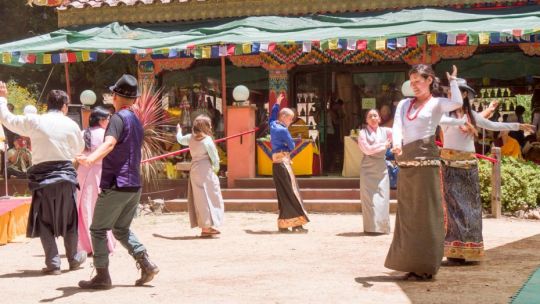
Tibetan dancers at the Medicine Buddha Festival in Soquel, California, US, July 2017. Photo courtesy of Denice Macy.
Don’t limit your audience. Rinpoche gave us the advice to invite all the area Dharma centers including Zen, mindfulness-based groups, Chinese, Vietnamese, and other Tibetan lineage centers. This is an opportunity to join with and welcome the diversity of our Dharma community. Of course, inviting other FPMT projects and centers is a must. Offer local FPMT family centers, projects, and services a table at your event to share information about their programs. Invite animal rescue groups or other non-profit organizations that align with benefiting sentient beings.
6. Re-read advice from Rinpoche on how to hold these large events.
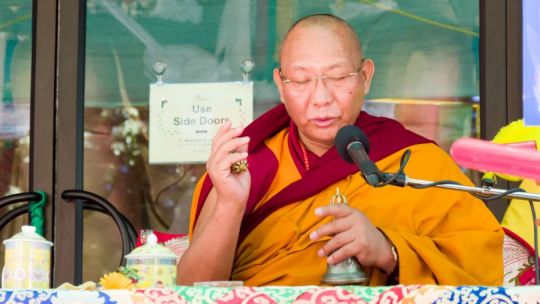
Dagri Rinpoche at the Land of Medicine Buddha Festival in Soquel, California, US, July 2017. Photo courtesy of Denice Macy.
Duh. Of course, none of us would intentionally ignore precious advice that we have received from Rimpoche. However, it is IMPORTANT to re-read advice (again, months in advance). You will likely find it is not possible to do everything Rinpoche advises right away, or even in the first few years of holding an annual event. You may find like us, however, that it is possible to add elements each year in a practical way. It took years for us to find Mongolian acrobats in our area, but eventually we did!
7. Practice generosity and pleasing sentient beings.
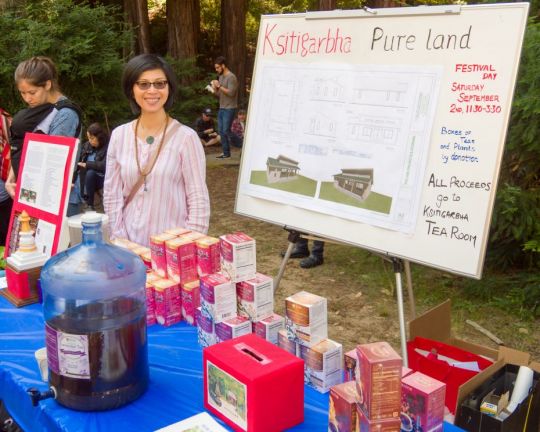
Fundraising and offering donations at the Medicine Buddha Festival, Soquel, California, US, July 2017. Photo courtesy of Denice Macy.
Make meaningful and generous offerings to the people who contribute to the day: festival t-shirts for volunteers, offerings of money and special treats to the Sangha, and generous offerings to those who make music or dance offerings. Here, remember to make as extensive offerings as possible on your altars, and give people an opportunity to sponsor those offerings. People from around the world who are unable to attend your event may have the wish to participate by sponsoring various offerings.
8. Support your team, meet, and follow up.
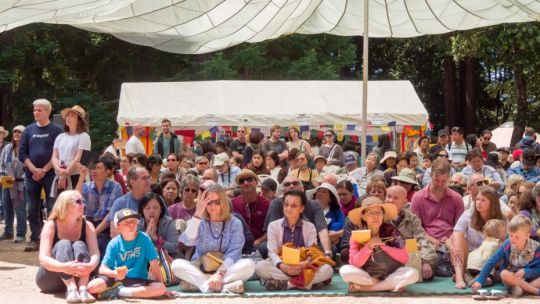
Attendees at the Medicine Buddha Festival in Soquel, California, US, July 2017. Photo courtesy of Denice Macy.
Even the most enthusiastic and reliable community members have obstacles that will arise. It is helpful to share information and to-do lists on Google Docs and other online methods of communication. Have a volunteer coordinator, logistics coordinator, liaison with performers, and parking coordinator. Make lists and meet in person with your team. Make plans to follow up so you can make adjustments as issues arise.
9. Remember that you may not have time in the last days before the event to do X, Y, or Z.
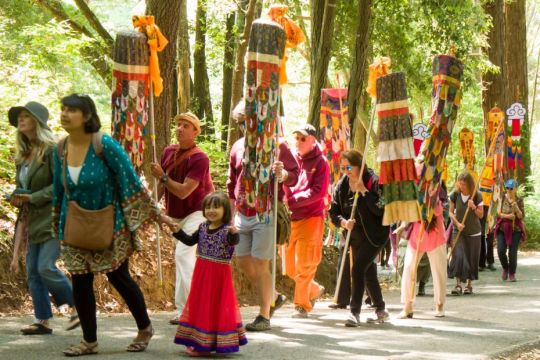
Parade at the Medicine Buddha Festival in Soquel, California, US, July 2017. Photo courtesy of Denice Macy.
Do it now! Funny things happen when making plans for Dharma events. One year in the middle of June, a large tree fell blocking the road to our center for more than twelve hours—the day before our event! Another year someone drove a car over a cliff. It is interesting to recall how obstacles can arise and surprise. If you leave things to the final days before an event, the stress level of your team may go through the roof. Do as much as you can now. Make lists with your team that can be completed well in advance. Leave a lot of space in the last few days to be surprised by things not going exactly as planned.
10. Trust your team!
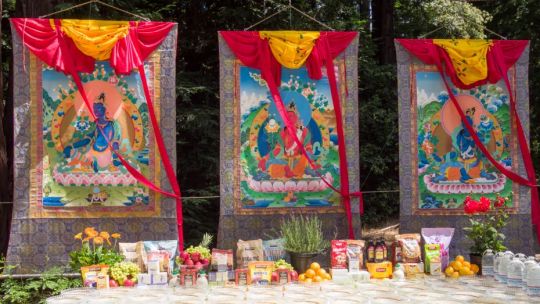
Three of the Eight Great Bodhisattvas, Land of Medicine Buddha, Soquel, California, US, July 2017. Photo courtesy of Denice Macy.
The mind that sees problems is persistent (speaking for myself here). Remember you have an amazing team with Rinpoche at the head; Rinpoche inspires us to stretch ourselves, and if we trust Rinpoche’s advice, we can move ahead with faith that we have the skill, team, and karma for a successful event. Though we are limited and may learn some uncomfortable lessons along the way, we are on the right path!
Read more about the festivities, spiritual programs, and life in the community at Land of Medicine Buddha: http://landofmedicinebuddha.org/
FPMT.org and Mandala Publications brings you news of Lama Zopa Rinpoche and of activities, teachings and events from over 160 FPMT centers, projects and services around the globe. If you like what you read, consider becoming a Friend of FPMT, which supports our work.
- Tagged: festival days, land of medicine buddha
- Home
- News/Media
- Study & Practice
- About FPMT Education Services
- Latest News
- Programs
- New to Buddhism?
- Buddhist Mind Science: Activating Your Potential
- Heart Advice for Death and Dying
- Discovering Buddhism
- Living in the Path
- Exploring Buddhism
- FPMT Basic Program
- FPMT Masters Program
- FPMT In-Depth Meditation Training
- Maitripa College
- Lotsawa Rinchen Zangpo Translator Program
- Universal Education for Compassion & Wisdom
- Online Learning Center
- Prayers & Practice Materials
- Overview of Prayers & Practices
- Full Catalogue of Prayers & Practice Materials
- Explore Popular Topics
- Benefiting Animals
- Chenrezig Resources
- Death & Dying Resources
- Lama Chopa (Guru Puja)
- Lama Zopa Rinpoche: Compendium of Precious Instructions
- Lama Zopa Rinpoche: Life Practice Advice
- Lama Zopa Rinpoche Practice Series
- Lamrim Resources
- Mantras
- Prayer Book Updates
- Purification Practices
- Sutras
- Thought Transformation (Lojong)
- Audio Materials
- Dharma Dates – Tibetan Calendar
- Translation Services
- Publishing Services
- Teachings and Advice
- Find Teachings and Advice
- Lama Zopa Rinpoche Advice Page
- Lama Zopa Rinpoche: Compendium of Precious Instructions
- Lama Zopa Rinpoche Video Teachings
- ༧སྐྱབས་རྗེ་བཟོད་པ་རིན་པོ་ཆེ་མཆོག་ནས་སྩལ་བའི་བཀའ་སློབ་བརྙན་འཕྲིན།
- Podcasts
- Lama Yeshe Wisdom Archive
- Buddhism FAQ
- Dharma for Young People
- Resources on Holy Objects
- Ways to Offer Support
- Centers
- Affiliates Area
- Teachers
- Projects
- Charitable Projects
- Make a Donation
- Applying for Grants
- News about Projects
- Other Projects within FPMT
- Support International Office
- Projects Photo Galleries
- Give Where Most Needed
- FPMT
- Shop
Translate*
*powered by Google TranslateTranslation of pages on fpmt.org is performed by Google Translate, a third party service which FPMT has no control over. The service provides automated computer translations that are only an approximation of the websites' original content. The translations should not be considered exact and only used as a rough guide.When you meet miserable conditions, it is extremely important to use skillful means. In other words, there is a meditation to mix with whatever suffering you experience. When you apply the teachings in this way, all sufferings are mixed with virtue. All experiences of suffering become virtue.
